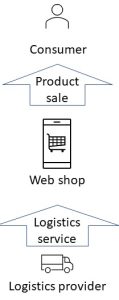A value model is not a process model
A value model shows the service provision relations among members of a value network. These are quite different from process models (Gordijn, et al., 2000). Putting it in another way: Value networks are not processes.
Phrased this way, this may seem obvious. But many people start designing a value network by following the transactions in a network of partners needed to deliver the product. This always leads to a process model. But a process model is not a value model.
For example, when a web shop sells a product to a customer, a logistics provider transports the product from the shop’s warehouse to the customer’s home. Tracing the product through the network, we get the following process.
 In the coordination process, customer physically interacts with the logistics provider when the product is delivered. But it does not buy the product from the logistics provider. It buys the product from the web shop.
In a value model, we show which value the members of a value network offer to each other. Think of these as legal contracts in which one actor provides a product, service, or outcome to another against a payment. A value model represents these contracts, or value provisions, as arrows. This gives us the following value model of the process shown above.
In the coordination process, customer physically interacts with the logistics provider when the product is delivered. But it does not buy the product from the logistics provider. It buys the product from the web shop.
In a value model, we show which value the members of a value network offer to each other. Think of these as legal contracts in which one actor provides a product, service, or outcome to another against a payment. A value model represents these contracts, or value provisions, as arrows. This gives us the following value model of the process shown above.
 This diagram shows who offers what value to whom. The shop buys a logistics service from a logistics provider, and the customer buys a product from the shop. These are the value-providing relations that must be shown in a value model.
This diagram shows who offers what value to whom. The shop buys a logistics service from a logistics provider, and the customer buys a product from the shop. These are the value-providing relations that must be shown in a value model.
 In the coordination process, customer physically interacts with the logistics provider when the product is delivered. But it does not buy the product from the logistics provider. It buys the product from the web shop.
In a value model, we show which value the members of a value network offer to each other. Think of these as legal contracts in which one actor provides a product, service, or outcome to another against a payment. A value model represents these contracts, or value provisions, as arrows. This gives us the following value model of the process shown above.
In the coordination process, customer physically interacts with the logistics provider when the product is delivered. But it does not buy the product from the logistics provider. It buys the product from the web shop.
In a value model, we show which value the members of a value network offer to each other. Think of these as legal contracts in which one actor provides a product, service, or outcome to another against a payment. A value model represents these contracts, or value provisions, as arrows. This gives us the following value model of the process shown above.
 This diagram shows who offers what value to whom. The shop buys a logistics service from a logistics provider, and the customer buys a product from the shop. These are the value-providing relations that must be shown in a value model.
This diagram shows who offers what value to whom. The shop buys a logistics service from a logistics provider, and the customer buys a product from the shop. These are the value-providing relations that must be shown in a value model.